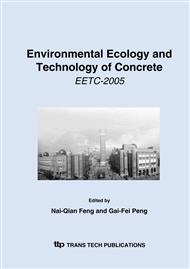p.314
p.321
p.329
p.339
p.347
p.356
p.363
p.371
p.376
Influence of Surface Treatment on Pore Structures of Cement-Based Materials
Abstract:
The objective of this investigation is to evaluate the effect of surface treatments on cement-based materials, which include mortar and concrete samples. Penetrated sealers and methyl methacrylate (MMA) were used as surface treatment materials. Two concrete mixes (w/c = 0.35, 0.55) were selected and cubic/cylindrical specimens were prepared according to ASTM specifications. The treated specimens have higher compressive strengths than the control specimens. Also, the absorptions and total charge passed of rapid chloride penetration test (RCPT) are lower in the treated specimens. Scanning electronic microscope (SEM) was utilized to estimate the microstructure of the specimens. Denser pore structures and narrower pore-size distribution were observed in SEM micrographs and mercury intrusion porosimetry (MIP) spectrum for the treated specimens, which are correspondent to the macro-observation. The positive effect is most prominent in polymer treated specimens. For higher w/c ratio mix, large capillary pores were filled by most of treatment materials and compressive strength significantly increased, while, for lower w/c ratio mix, polymer and silicate sealer filled in medium capillary pores as indicated by MIP and RCPT results.
Info:
Periodical:
Pages:
347-355
Citation:
Online since:
January 2006
Authors:
Price:
Сopyright:
© 2006 Trans Tech Publications Ltd. All Rights Reserved
Share:
Citation:


